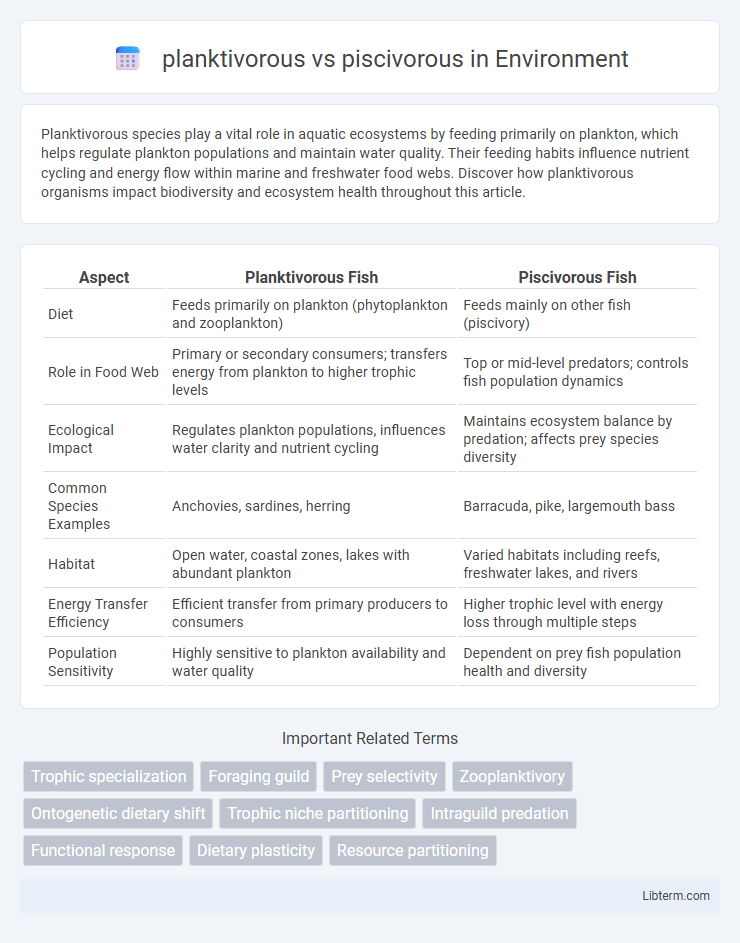Planktivorous species play a vital role in aquatic ecosystems by feeding primarily on plankton, which helps regulate plankton populations and maintain water quality. Their feeding habits influence nutrient cycling and energy flow within marine and freshwater food webs. Discover how planktivorous organisms impact biodiversity and ecosystem health throughout this article.
Table of Comparison
| Aspect | Planktivorous Fish | Piscivorous Fish |
|---|---|---|
| Diet | Feeds primarily on plankton (phytoplankton and zooplankton) | Feeds mainly on other fish (piscivory) |
| Role in Food Web | Primary or secondary consumers; transfers energy from plankton to higher trophic levels | Top or mid-level predators; controls fish population dynamics |
| Ecological Impact | Regulates plankton populations, influences water clarity and nutrient cycling | Maintains ecosystem balance by predation; affects prey species diversity |
| Common Species Examples | Anchovies, sardines, herring | Barracuda, pike, largemouth bass |
| Habitat | Open water, coastal zones, lakes with abundant plankton | Varied habitats including reefs, freshwater lakes, and rivers |
| Energy Transfer Efficiency | Efficient transfer from primary producers to consumers | Higher trophic level with energy loss through multiple steps |
| Population Sensitivity | Highly sensitive to plankton availability and water quality | Dependent on prey fish population health and diversity |
Introduction to Planktivorous and Piscivorous Feeding Strategies
Planktivorous feeding strategies involve organisms consuming plankton, primarily microscopic plants and animals, playing a crucial role in aquatic food webs by linking primary producers to higher trophic levels. Piscivorous feeding strategies target fish prey, often seen in larger predatory species that regulate fish population dynamics and maintain ecosystem balance. Understanding the differences between planktivorous and piscivorous diets highlights their distinct ecological functions and energy transfer mechanisms within aquatic environments.
Defining Planktivorous Species
Planktivorous species primarily consume plankton, including microscopic plants and animals, playing a crucial role in aquatic food webs by transferring energy from primary producers to higher trophic levels. These organisms often exhibit adaptations such as specialized gill rakers for efficient plankton filtration. Unlike piscivorous species, which feed on other fish, planktivores influence nutrient cycling and ecosystem productivity through their consumption of plankton communities.
Understanding Piscivorous Species
Piscivorous species primarily consume fish, playing a crucial role in regulating aquatic food webs and maintaining ecosystem balance. These predators exhibit specialized hunting strategies and morphological adaptations such as sharp teeth and streamlined bodies to capture and consume prey effectively. Understanding piscivorous species involves studying their feeding habits, habitat preferences, and impact on prey populations, which can inform fisheries management and conservation efforts.
Evolutionary Adaptations in Planktivores and Piscivores
Planktivorous fish have evolved specialized gill rakers that are fine and closely spaced, enabling efficient filtration of microscopic plankton from the water column. In contrast, piscivorous fish exhibit sharp, robust teeth and streamlined bodies adapted for swift predation and capture of agile fish prey. These distinct morphological and physiological adaptations reflect divergent evolutionary pressures driven by feeding strategies and ecological niches occupied by planktivores and piscivores.
Differences in Morphology and Physiology
Planktivorous fish typically exhibit specialized gill rakers that are long and closely spaced, enabling efficient filtration of tiny plankton from water, while piscivorous fish have shorter, spaced gill rakers suited for capturing larger prey. Morphologically, piscivorous species often possess robust jaws and sharp teeth designed for gripping and tearing fish, contrasting with the smaller, more delicate oral structures of planktivorous species adapted to filter feeding. Physiologically, piscivores generally have a faster digestive process and higher enzymatic activity to process protein-rich prey, whereas planktivores exhibit adaptations for handling large volumes of low-nutrient plankton efficiently.
Habitat Preferences and Distribution
Planktivorous fish predominantly inhabit pelagic zones of oceans, lakes, and rivers where plankton concentrations are high, favoring open, nutrient-rich waters that support abundant microscopic food sources. Piscivorous species are commonly found in diverse environments including coastal reefs, freshwater lakes, and deep oceans, often occupying predator niches with access to smaller fish populations. Distribution patterns reflect these dietary preferences, with planktivores thriving in areas of high plankton productivity and piscivores concentrating in habitats that enable effective hunting strategies for fish prey.
Trophic Roles in Aquatic Ecosystems
Planktivorous fish primarily consume zooplankton and phytoplankton, playing a critical role in controlling plankton populations and facilitating energy transfer from lower to higher trophic levels. Piscivorous fish prey on other fish, regulating prey fish populations and maintaining species diversity within aquatic ecosystems. The balance between planktivorous and piscivorous species influences nutrient cycling, food web dynamics, and overall ecosystem stability in freshwater and marine environments.
Impact on Food Web Dynamics
Planktivorous fish primarily consume plankton, regulating plankton populations and influencing primary production rates, which stabilizes nutrient cycling within aquatic ecosystems. Piscivorous fish prey on other fish species, controlling the abundance and diversity of lower trophic levels and promoting trophic cascades that impact species composition and ecosystem resilience. The balance between planktivorous and piscivorous fish shapes food web dynamics by modulating energy flow and maintaining ecological equilibrium in freshwater and marine environments.
Case Studies: Planktivorous vs Piscivorous Fish
Case studies comparing planktivorous and piscivorous fish highlight distinct ecological roles, with planktivorous species primarily consuming plankton, influencing nutrient cycling and water clarity in aquatic ecosystems. Piscivorous fish, being predators of other fish, regulate prey populations and maintain trophic balance, often impacting fish community structure and biodiversity. Research reveals that shifts in the abundance of planktivorous or piscivorous fish can lead to cascading effects on food web dynamics and ecosystem health.
Conservation Implications and Future Research Directions
Planktivorous fish play a crucial role in aquatic ecosystems by regulating plankton populations, which supports water quality and nutrient cycling, while piscivorous fish maintain balance by controlling smaller fish populations. Conservation efforts must tailor strategies to protect both groups, considering that overfishing of piscivores can lead to trophic cascades affecting biodiversity and ecosystem stability. Future research should focus on the impacts of climate change and habitat degradation on trophic interactions, as well as developing sustainable management practices that preserve the functional diversity of both planktivorous and piscivorous species.
planktivorous Infographic

 libterm.com
libterm.com